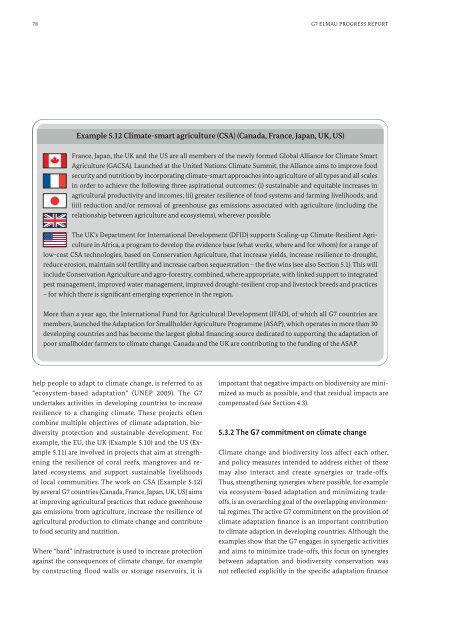G7-Elmau-Progress-Report-2015-Biodiversity-A-vital-foundation-for-sustainable-development
G7-Elmau-Progress-Report-2015-Biodiversity-A-vital-foundation-for-sustainable-development
G7-Elmau-Progress-Report-2015-Biodiversity-A-vital-foundation-for-sustainable-development
Create successful ePaper yourself
Turn your PDF publications into a flip-book with our unique Google optimized e-Paper software.
78 <strong>G7</strong> ELMAU PROGRESS REPORTExample 5.12 Climate-smart agriculture (CSA) (Canada, France, Japan, UK, US)France, Japan, the UK and the US are all members of the newly <strong>for</strong>med Global Alliance <strong>for</strong> Climate SmartAgriculture (GACSA). Launched at the United Nations Climate Summit, the Alliance aims to improve foodsecurity and nutrition by incorporating climate-smart approaches into agriculture of all types and all scalesin order to achieve the following three aspirational outcomes: (i) <strong>sustainable</strong> and equitable increases inagricultural productivity and incomes; (ii) greater resilience of food systems and farming livelihoods; and(iii) reduction and/or removal of greenhouse gas emissions associated with agriculture (including therelationship between agriculture and ecosystems), wherever possible.The UK’s Department <strong>for</strong> International Development (DFID) supports Scaling-up Climate-Resilient Agriculturein Africa, a program to develop the evidence base (what works, where and <strong>for</strong> whom) <strong>for</strong> a range oflow-cost CSA technologies, based on Conservation Agriculture, that increase yields, increase resilience to drought,reduce erosion, maintain soil fertility and increase carbon sequestration – the five wins (see also Section 5.1). This willinclude Conservation Agriculture and agro-<strong>for</strong>estry, combined, where appropriate, with linked support to integratedpest management, improved water management, improved drought-resilient crop and livestock breeds and practices– <strong>for</strong> which there is significant emerging experience in the region.More than a year ago, the International Fund <strong>for</strong> Agricultural Development (IFAD), of which all <strong>G7</strong> countries aremembers, launched the Adaptation <strong>for</strong> Smallholder Agriculture Programme (ASAP), which operates in more than 30developing countries and has become the largest global financing source dedicated to supporting the adaptation ofpoor smallholder farmers to climate change. Canada and the UK are contributing to the funding of the ASAP.help people to adapt to climate change, is referred to as“ecosystem-based adaptation” (UNEP 2009). The <strong>G7</strong>undertakes activities in developing countries to increaseresilience to a changing climate. These projects oftencombine multiple objectives of climate adaptation, biodiversityprotection and <strong>sustainable</strong> <strong>development</strong>. Forexample, the EU, the UK (Example 5.10) and the US (Example5.11) are involved in projects that aim at strengtheningthe resilience of coral reefs, mangroves and relatedecosystems, and support <strong>sustainable</strong> livelihoodsof local communities. The work on CSA (Example 5.12)by several <strong>G7</strong> countries (Canada, France, Japan, UK, US) aimsat improving agricultural practices that reduce greenhousegas emissions from agriculture, increase the resilience ofagricultural production to climate change and contributeto food security and nutrition.Where “hard” infrastructure is used to increase protectionagainst the consequences of climate change, <strong>for</strong> exampleby constructing flood walls or storage reservoirs, it isimportant that negative impacts on biodiversity are minimizedas much as possible, and that residual impacts arecompensated (see Section 4.3).5.3.2 The <strong>G7</strong> commitment on climate changeClimate change and biodiversity loss affect each other,and policy measures intended to address either of thesemay also interact and create synergies or trade-offs.Thus, strengthening synergies where possible, <strong>for</strong> examplevia ecosystem-based adaptation and minimizing tradeoffs,is an overarching goal of the overlapping environmentalregimes. The active <strong>G7</strong> commitment on the provision ofclimate adaptation finance is an important contributionto climate adaption in developing countries. Although theexamples show that the <strong>G7</strong> engages in synergetic activitiesand aims to minimize trade-offs, this focus on synergiesbetween adaptation and biodiversity conservation wasnot reflected explicitly in the specific adaptation finance


